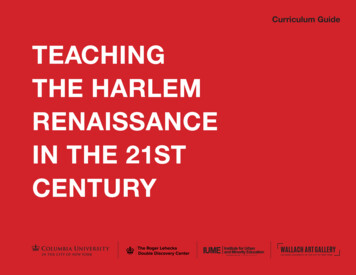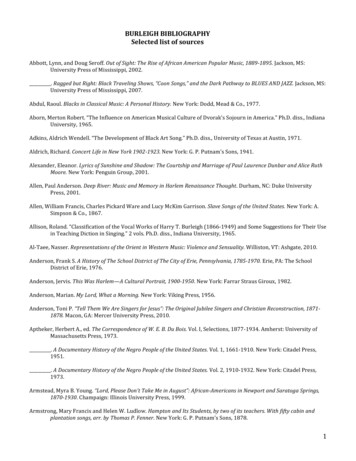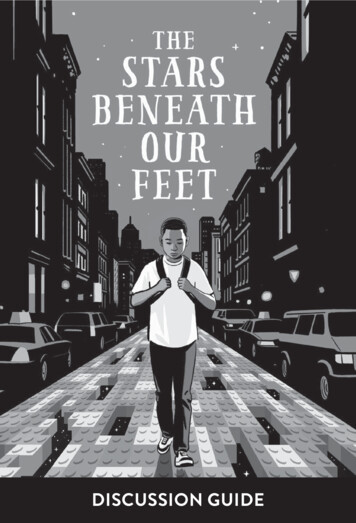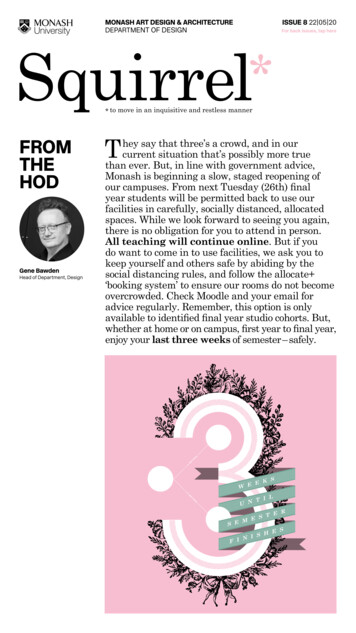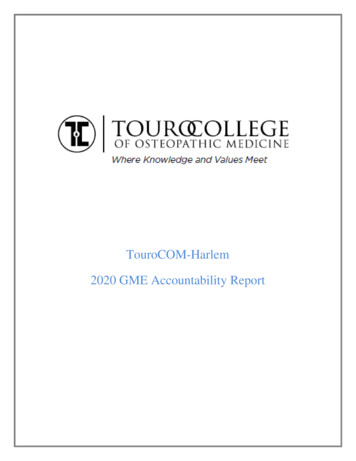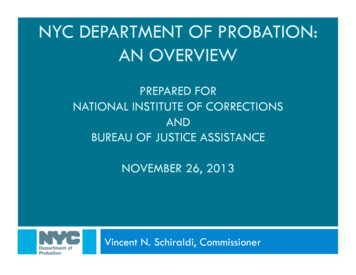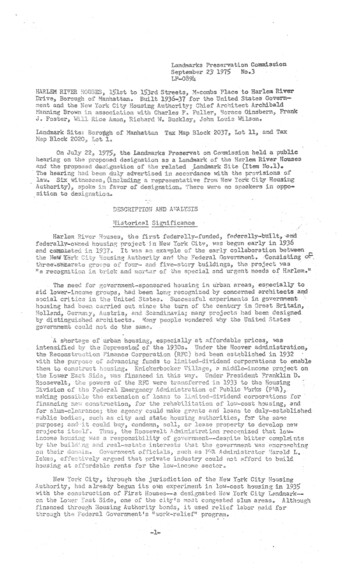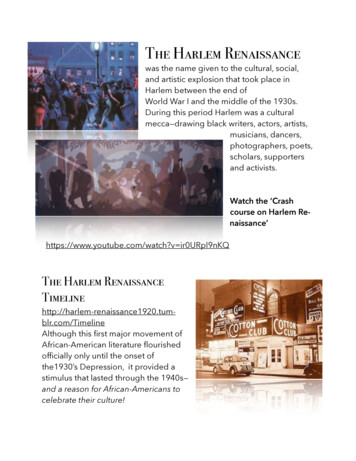
Transcription
The Harlem Renaissancewas the name given to the cultural, social,and artistic explosion that took place inHarlem between the end ofWorld War I and the middle of the 1930s.During this period Harlem was a culturalmecca—drawing black writers, actors, artists,musicians, dancers,photographers, poets,scholars, supportersand activists.Watch the ‘Crashcourse on Harlem Renaissance’https://www.youtube.com/watch?v ir0URpI9nKQThe Harlem umblr.com/TimelineAlthough this first major movement ofAfrican-American literature flourishedofficially only until the onset ofthe1930’s Depression, it provided astimulus that lasted through the 1940s—and a reason for African-Americans tocelebrate their culture!
But Harlem was much more than just a place for celebration—it was a literary movement featuring popular writers, intellectuals and activists suchas Langston Hughes, W.E.B. DuBois, Zora Neale Hurston, and severalothers (including Claude McKay, Jean Toomer, Rudolf Fisher, WallaceThurman, and NellaLarsen).Some scholars consider the Harlem Renaissance to be thevery moment AfricanAmerican literaturefirstcameinto itsown andcredit it with being instrumental in theevolution of an entire group of people,formerly enslaved and illiterate, who became both free and literary over theshort span of fifty years!
authors and Stories of the Harlem tmlhttp://www.pbs.org/wnet/jimcrow/stories events harlem.htmlLangston ston-hughesW.E.B. DuBois‘One ever feels his twoness - an American, a Negro; two souls, two thoughts, two unreconciled strivings; two warring ideals in one dark body, whose dogged strengthalone keeps it from being torn eb-du-bois-9279924Zora Neale /about-this-collection/Their Eyes were Watching God Movie (Hurston)https://www.youtube.com/watch?v teUi8N5ZaNs
The Harlem Renaissancewasalso instrumental in the birth of important organizations which, in turn, supported African American culture in theUnited States: the NAACP (National Association for the Advancement of Colored People-1909) , the NUL (National Urban League-1910), followed byUNIA in 1914 (established by Marcus Garvey) to instill racial pride andeconomic self-sufficiency for Black people in America and throughout thePan African world.‘Founded in 1909 by DuBois, the NAACP is the nation's oldest andlargest civil rights organization. From the ballot box to the classroom, thethousands of dedicated workers, organizers, leaders and members whomake up the NAACP continue to fight for social justice for all ories events crisis.htmlThe Crisis Magazine (DuBois)
Music of The HarlemRenaissanceHarlem's Cotton Clubboasted the talents ofDuke Ellington whileBessie Smith and Billie Holiday popularized blues andjazz . In addition, Jelly Roll Morton and Louis Armstrong drew huge crowds of white Americans as theyjoined African Americans in jazz fever.Duke Ellingtonhttp://www.pbs.org/jazz/biography/artist id ellington gton-9286338http://www.dukeellington.com/Billie Holidayhttp://www.pbs.org/jazz/biography/artist id holiday t id armstrong louis.htmhttps://www.louisarmstronghouse.org/
Art and Artists ofThe Harlem renaissance‘Between 1920-1930 an outburst of creativityamong African American occurred in everyaspect of art. This cultural movement became known as ‘TheNew Negro Movement’ later the‘Harlem Renaissance’.Harlem attracted aprosperous and stylishmiddle class which sprouted an artistic center. African Americans wereencouraged to celebrate their heritage and tobecome "The NewNegro" a term coinedin 1925 by sociologistand critic Alain /wnet/aaworld/arts/artfocus 03.html
The10 ‘Must-Knows’ ofThe Harlem Renaissance1. The Great Migration: a massive movement offormerly oppressed Southern blacks to the North,with dreams of racial equality and economic opportunity. This population migration is what madethe Harlem Renaissance possible.2. The "New Negro”: a name to African Americans' evolving identities."The New Negro" was also the original name for the Harlem Renaissanceitself.3. The Rise of Jazz: Duke Ellington, Louis Armstrong, Billie Holiday (toname just a few)4. W.E.B. Du Bois's Concept of Duality (or ‘Twoness’) One ever feels histwoness - an American, a Negro; two souls, two thoughts, two unreconciled strivings; two warring ideals in one dark body, whose doggedstrength alone keeps it from being torn asunder.5. Racial Division: The Racial Division during the time of The Harlem Renaissance produced what Du Bois called "second sight": that ability tosee the world and the self from (at least) two different angles.6. Pan-Africanism and the black Nationalist movement began with theefforts of Marcus Garvey—it was a call for African people across the globeto unite.7. Modernism: You already know a lot about modernism: New, fresh,Avant-garde, etc., etc.8. High/Low Culture:What you get when you mix what's usually considered "high art" with"popular art" (or the mundane).9. Socialism/Communism: Socialism and Communism were favorites ofthe more politically minded writers of the Harlem Renaissance because oftheir shared commitment to the equal distribution of resources.10. Urbanity: Harlem Renaissance times were cool, sophisticated and‘totally rad’!
Assignments for Assignment #9:The Harlem Renaissance1. Explore all provided links to learn about the individuals who created and participated in the time periodof The Harlem Renaissance. Spend a lot of time exploring the ‘Drop Me off in Harlem’ Arts EdgeKennedy Center ves/harlem/faces/index.html#artists.2. Watch the movie based upon Zora Neale Hurston’s‘Their Eyes were Watching God’https://www.youtube.com/watch?v teUi8N5ZaNs3. Listen to Langston Hughes reading his poem‘Dreams’ at https://www.youtube.com/watch?v hz2IOjuxMy0&list RDhz2IOjuxMy0#t 9
But Harlem was much more than just a place for celebration—it was a lit- erary movement featuring popular writers, intellectuals and activists such as Langston Hughes, W.E.B. DuBois, Zora Neale Hurston, and several others (including Claude McKay, Jean Toomer, Rudolf Fisher, Wallace Thurman, and Nella Larsen). Some scholars con-sider the Harlem Re-


